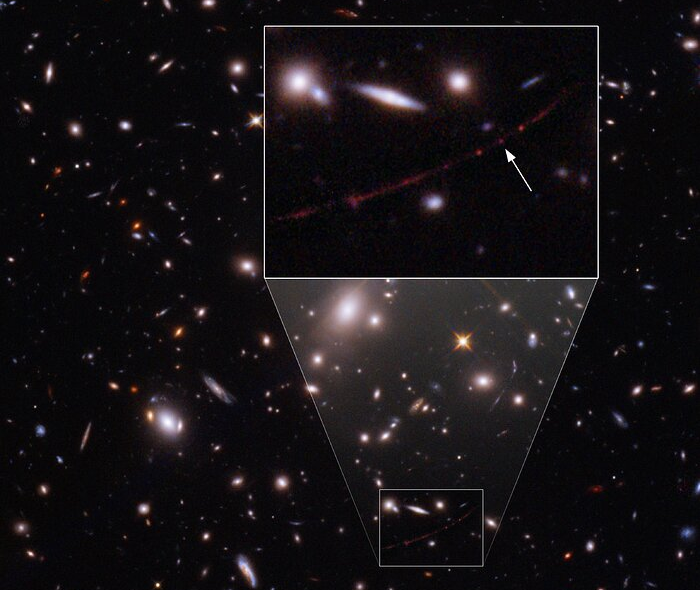The NASA/ESA Hubble Space Telescope has set a new record for detection of the farthest distant individual star ever seen. The star is so far away that its light took 12.9 billion years to reach Earth.
This star lived inside the first billion years after the Big Bang. The previous single-star record holder was discovered by Hubble in 2018. That star lived when the universe was around 4 billion years old, or 30% of its current age, a period is known as “redshift 1.5.” The term “redshift” is used by scientists to describe how, as the Universe expands, light from distant objects is stretched or “shifted” to longer, redder wavelengths as it approaches us.
The newly discovered star is coming to us with a redshift of 6.2, when the universe was just 7% of its present age. Previously, the smallest objects detected at such a tremendous distance were groupings of stars embedded within early galaxies.
Will you offer us a hand? Every gift, regardless of size, fuels our future.
Your critical contribution enables us to maintain our independence from shareholders or wealthy owners, allowing us to keep up reporting without bias. It means we can continue to make Jewish Business News available to everyone.
You can support us for as little as $1 via PayPal at office@jewishbusinessnews.com.
Thank you.
The composition of the star dubbed Earendel will be of considerable interest to astronomers, as it formed before the Universe was filled with the heavy elements created by successive generations of huge stars. If subsequent analyses confirm that Earendel is composed entirely of primordial hydrogen and helium, it would provide the first evidence for the legendary Population III stars, which are believed to be the very first stars to emerge following the Big Bang.
“We almost didn’t believe it at first, it was so much farther than the previous most distant, highest redshift star,” said astronomer Brian Welch of the Johns Hopkins University in Baltimore, lead author of the paper describing the discovery, which is published in the journal Nature.
“Normally at these distances, entire galaxies look like small smudges, the light from millions of stars blending together,” said Welch. “The galaxy hosting this star has been magnified and distorted by gravitational lensing into a long crescent that we named the Sunrise Arc.” After studying the galaxy in detail, Welch determined that one feature is an extremely magnified star that he called Earendel, which means “morning star” in Old English. The discovery holds the promise of opening up an uncharted era of very early star formation.
“There’s a long-standing theoretical prediction that stars that form solely out of the elements that were forged shortly after the Big Bang — hydrogen, helium and trace amounts of lithium — should be more massive than the stars that form today,” added team member Erik Zackrisson, of the Department of Physics and Astronomy at Uppsala University in Sweden. “These primordial stars, known as Population III stars, have so far eluded observers, but could be rendered detectable if subject to very high magnification by gravitational lensing, as in the case of the Earendel object.”
Earendel is estimated to be at least 50 times the mass of our Sun and millions of times brighter than our Sun, rivaling the most massive stars known. However, even such a dazzling, extremely massive star would be invisible at such a long distance without the aid of natural magnification provided by a massive galaxy cluster, in this case WHL0137-08, which lies between us and Earendel. The mass of the galaxy cluster bends and considerably amplifies the light from distant objects behind it.
The star Earendel appears directly on, or quite close to, a ripple in the fabric of space due to its unique alignment with the magnifying galaxy cluster. This ripple, referred to as a “caustic” in optics, gives maximum magnification and brightness. On a sunny day, the rippling surface of a swimming pool creates patterns of dazzling light on the pool’s bottom. The ripples on the surface operate as lenses, focusing sunlight to the pool floor’s maximum brightness.
This caustic allows the star Earendel to stand out from the rest of the galaxy’s brightness. Its brilliance is enhanced by a factor of a thousand or more. While astronomers are unsure whether Earendel is a binary star at the moment, most big stars do have at least one smaller partner star.
“Webb’s photos and spectra will enable us to establish that Earendel is a star and constrain its age, temperature, mass, and radius,” team member Jose Maria Diego of Spain’s Instituto de Fsica de Cantabria noted. “By combining Hubble and Webb views, we will be able to learn about microlenses in the galaxy cluster, which may include strange objects like as primordial black holes.”
“We may observe stars even further away than Earendel with Webb, which would be incredible,” Welch added. “We’ll go back as far as possible. I’d love to see Webb break Earendel’s record for distance.”




